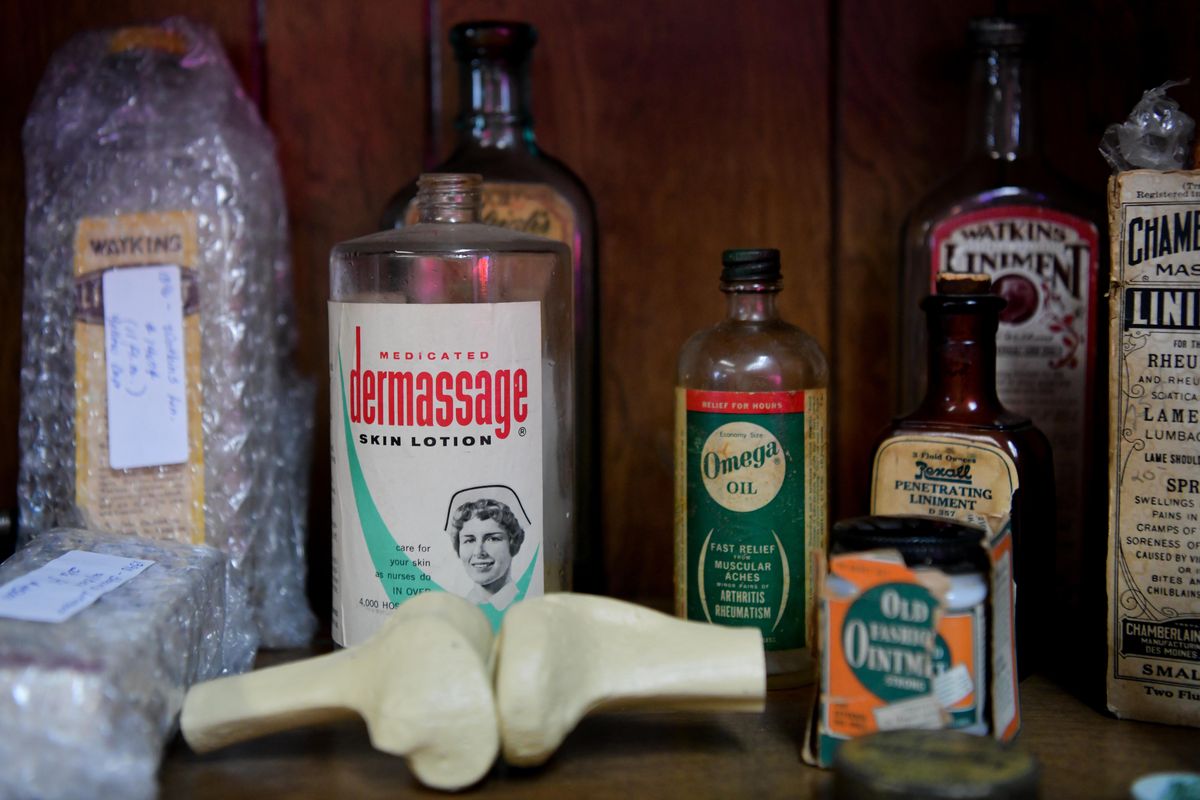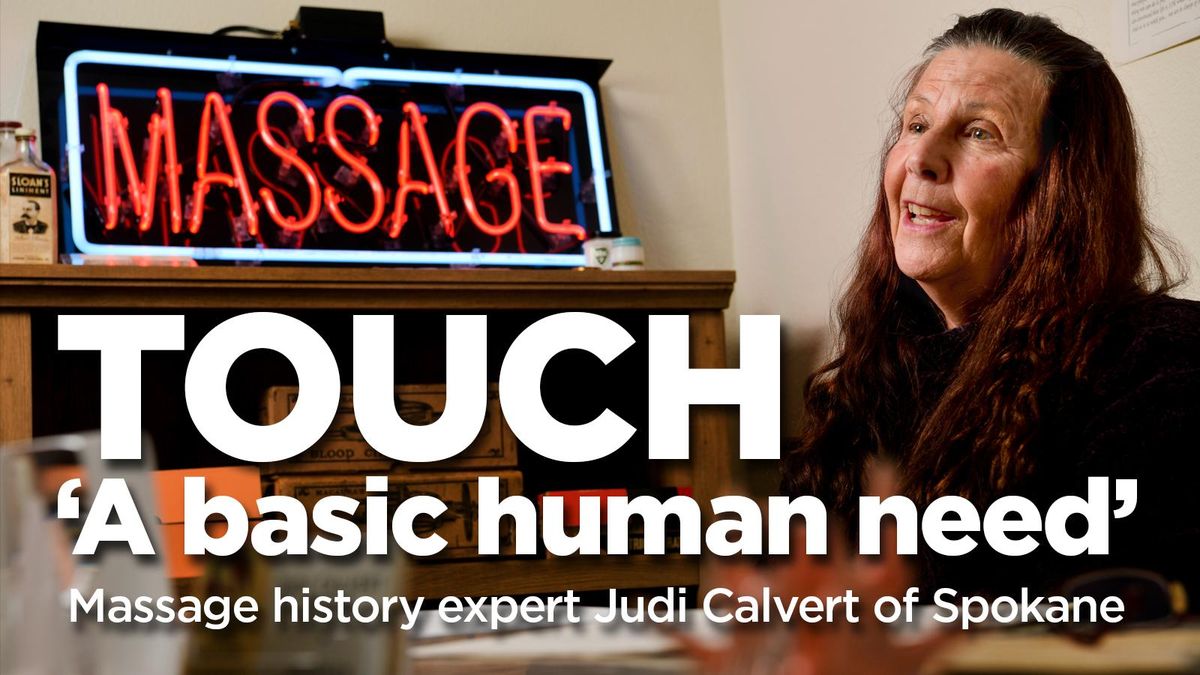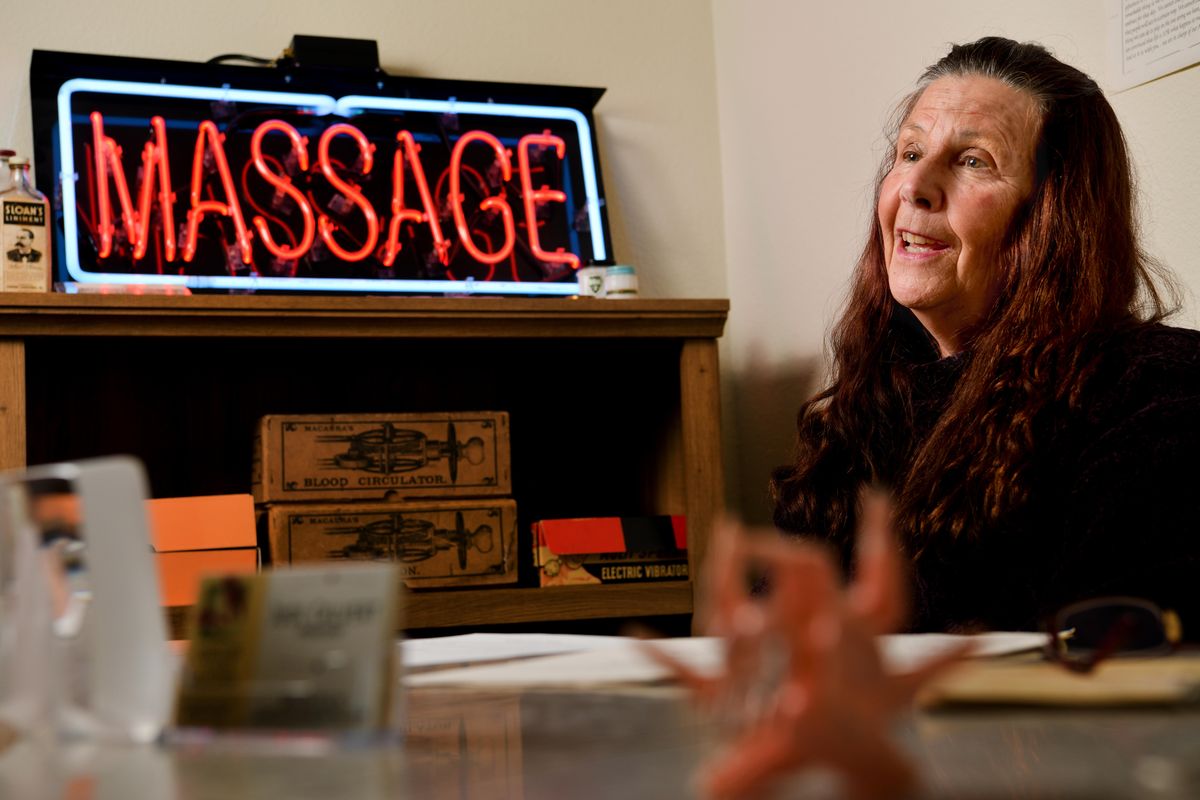Touch is ‘a basic human need’: Spokane native a global authority on massage history
Judi Calvert smiles as she talks about her massage memorabilia collection on Oct. 2 in Spokane. (Tyler Tjomsland / The Spokesman-Review)Buy a print of this photo
Judi Calvert is the living embodiment of the history of massage, one of the oldest forms of therapy dating back to the beginning of man. She lives it, teaches it, practices it and collects the history and artifacts of touch and how it’s intertwined with human history.
Calvert, a Spokane native, is one of the few world authorities on massage history and has traveled the globe collecting more than 4,000 objects related to massage, including about 165 vibrating machines that were commonplace in barbershops, hardware stores and the Sears and Roebuck catalog.
Massage was a self-help way people could relax face, neck and body because people rarely saw doctors.
“She’s an important pioneer,” said Elaine Stillerman, a licensed massage therapist in Brooklyn, New York, who created the protocols for pregnancy and infant massage. “The history gives us a strong foundation of where (touch) modalities came from. It gives you roots.”
There is no physical museum, although Calvert, 69, and her late husband, Robert, did briefly open one in Spokane in 2004. Instead, Calvert calls it a traveling museum and shares her collection with people at conventions, seminars and other events across the country.
She also teaches massage history courses, mostly to licensed practitioners who need continuing education credits. And, of course, she’s a massage therapist specializing in Swedish massage and shiatsu.
“It’s so important to educate people about the positive benefits of massage and positive touch,” Calvert said, adding that touch is the first human sense to develop.
“Touch is timeless,” she said. “It’s a basic human need. All humans need touch to survive. Touch is ultimate communication. It keeps us connected to one another.”
She said touch is especially important in a world that is consumed with stress, sleeplessness and technology. She believes students should get massages and learn life-long massage techniques in grade school so that people begin learning how to heal themselves and others.
The first item Calvert collected was a body roller from the early 1900s that came with a booklet telling about the therapeutic value and history of massage.
It was the mid-1980s, and massage still wasn’t mainstream. States were just beginning to license massage therapists, and the stigmatic link between massage and prostitution was prevalent.
Sports massage, which was gaining popularity at the time as pioneering practitioners brought it to the U.S. Olympic teams and collegiate sports teams, helped dissolve many negative associations with massage.
The information booklet jolted Calvert. How could massage be negative if it had such a long and positive history? That’s when Calvert and her husband became historians, launching into a lifetime of research and a need to educate.
“Touching behavior is as old as creation itself,” Calvert said while taking antique containers of Pompeian Facial Massage Cream from a display case. “Animals were first to use touch. Humans watched that animal and grooming behavior.”
Calvert and her husband, who are both inductees of the World Massage Therapy Hall of Fame, were already making and recording massage history.
The couple co-founded Massage Magazine in 1985, a time when massage was gaining acceptance in mainstream American culture as people became more engaged with fitness and health and the mind-body connection.
The magazine allowed them to travel the world, interviewing and learning from masters and pioneers of varying modalities.
They hiked 8 hours to a secluded Mexican village in the Sierra Madre Mountains, the first Caucasians to visit, and interviewed a Tarahumara shaman who had gathered other shamans in the area to share their touch work.
They spent three weeks in New Zealand learning about yabung, a type of massage practiced by Aboriginal medicine men.
They visited practitioners in China, Fiji, Thailand, India and other countries. The published interviews helped educate practitioners about different modalities and bodywork and promoted massage worldwide.
While traveling, Judi Calvert always went to antique stores looking for massage artifacts. The couple sold Massage in 2005, and Robert died in 2006. Yet Calvert continues to uncover and unravel massage history and shares the story with students and therapists around the world.
Besides the general history, Calvert also has classes on the histories of sports massage, various massage tools and massage in the beauty industry. A lot of the curriculum is from the book Robert Calvert wrote in 2002, “The History of Massage: An Illustrated Survey From Around the World.”
Stillerman met the Calverts in 1992 in San Francisco when the couple co-founded the Anatriptic Arts Expo, the first international showcase of healing arts. She credits the Calverts for “verifying our proper place in the healing arts.”
“She not only has a collection of artifacts that’s bar none, but she’s traveled the world and experienced it, met these leaders and has first-hand knowledge,” Stillerman said.
Calvert’s nondescript South Hill office has massage artifacts in every corner and on every shelf. A large majority of the collection is packed in storage. There are glass jars of liniments and massage creams, early 1900s product posters, wooden tables and facial rollers.
Hundreds of hard-covered books with varying mentions and descriptions of touch therapy fill bookshelves. The collection includes a 1951 translation of Galen’s Hygiene Book. Galen admired Hippocrates and was a Greek physician in Rome who treated gladiators with massage.
Calvert is currently writing histories on the use of massage in war and the history of massage use by physicians and nurses. There is an anatomy book from 1850 that includes a chapter on massage.
The oldest item in Calvert’s collection is a 1,000-year-old jade massage “knuckle” for the muscles along the spine up the neck and out to the shoulder. The next oldest item is a poster from 1837 for Dr. Swift Massage. She found it on the wall of an old gas station in Idaho.
There are Dr. Macauras blood circulators – hand-crank vibrators with wooden handles, a shelf of STIM-U-LAX massage instruments used by barbers in the 1900s and an electric massage cushion from 1949 that comes in a briefcase for traveling businessmen who needed relaxation on the road.
Calvert even traveled to Hollywood and MGM Studios to research the use of massage in motion pictures and the female massage therapists who worked on movie stars in the 1920s and ’30s.
Calvert’s association with massage is long and deep, beginning in 1984 when her sister suggested they take a weekend do-it-yourself massage class. She knew nothing about massage but loved the relief it gave her from sore, tired muscles from martial arts practice.
She then signed up for massage school to become a licensed practitioner. The teacher was Robert Calvert, who she soon married. “I didn’t know anything about massage,” Calvert said.
“I never in my wildest dreams thought it would take me around the world, start an international magazine, create a museum and allow me to educate people about the benefits of massage. It’s just been a wonderful journey. And it’s still going.”


